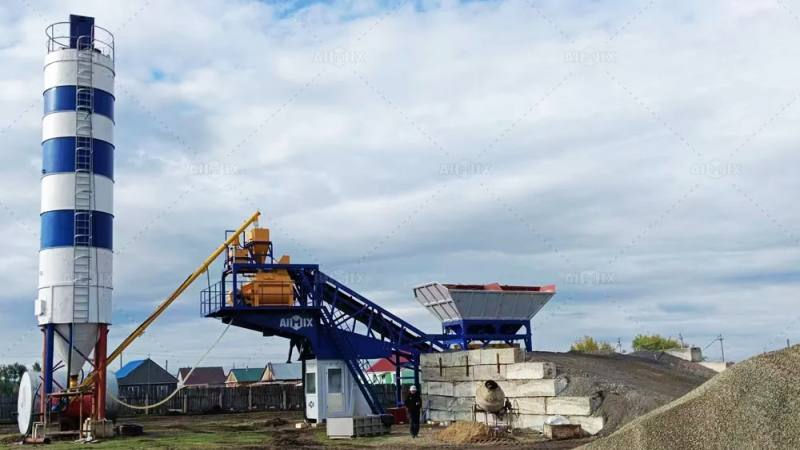Reducing Mobile Concrete Batching Plant Price Through Smart Design and Innovation
- aimixglobal5
- Aug 26, 2025
- 3 min read
In today’s construction industry, mobility, efficiency, and cost-effectiveness are critical factors influencing equipment investment decisions. Among the most popular solutions, the mobile concrete batching plant has gained attention for its ability to deliver high-quality concrete on-site while reducing transportation and operational costs. However, many contractors and project owners face challenges in managing the overall mobile concrete batching plant price. Smart design improvements and innovative features are reshaping the way manufacturers and buyers approach these costs, ensuring better value for money and higher return on investment.

The Rising Importance of Mobile Concrete Batching Plants
The demand for mobile plants is rising worldwide due to infrastructure growth, urbanization, and the need for flexible construction solutions. Traditional stationary batching plants are ideal for large-scale, long-term projects, but they are less efficient for smaller or frequently relocating construction sites. Mobile batching plants solve this problem by offering:
Quick setup and relocation within a matter of hours.
Lower logistics costs, since aggregates and concrete can be produced directly on-site.
Reduced dependency on third-party suppliers, ensuring better control over project timelines and quality.
Because of these benefits, markets such as mobile batching plant Indonesia and mobile batching plant for sale Australia are experiencing notable growth, driven by infrastructure expansion and sustainable construction practices.
Factors That Influence Mobile Concrete Batching Plant Price
Several elements affect the final price of a mobile batching plant:
Capacity and Output – Higher-capacity models naturally cost more but reduce cost per cubic meter in high-volume projects.
Design and Mobility Features – Compact designs with modular components make transport easier, lowering overall logistics costs.
Automation Level – Plants equipped with advanced automation and control systems often have higher upfront costs but lower long-term operating expenses.
Durability and Material Quality – Use of high-strength steel, wear-resistant mixers, and efficient conveyors increase lifespan and reduce maintenance.
Supplier Location – A mobile batching plant for sale Australia might be priced higher due to stricter regulations and higher labor costs compared to a mobile batching plant Indonesia, where localized production and materials can reduce expenses.
How Smart Design Reduces Plant Costs
Innovations in plant design directly contribute to lowering the mobile concrete batching plant price:
Modular Construction – Plants designed in modular units reduce installation time and transportation costs, making them easier to set up in remote areas.
Lightweight Frames – Use of high-strength yet lightweight materials reduces trailer loads, cutting fuel consumption during transportation.
Compact Layout – Optimized footprints minimize land use and foundation requirements, which is especially beneficial in urban construction zones.
Energy-Efficient Mixers – Modern twin-shaft or planetary mixers consume less power while achieving faster mixing cycles.
Such design optimizations make mobile batching plants more affordable in both purchase and operational terms.

The Role of Innovation in Lowering Costs
Technological innovation plays an equally vital role in bringing down plant costs:
Automation & Digital Control – Advanced control systems reduce labor requirements and ensure precise batching, minimizing material wastage.
IoT Monitoring – Real-time data tracking helps optimize energy use and predictive maintenance, extending equipment lifespan.
Hybrid Power Systems – Some modern plants integrate renewable energy sources or fuel-efficient generators, lowering long-term operational costs.
Sustainable Additions – Dust collection systems, water recycling units, and eco-friendly designs help companies meet environmental standards without costly retrofits.
These innovations not only reduce expenses but also increase the competitiveness of plants in global markets.
Case Insights: Indonesia and Australia
Mobile Batching Plant Indonesia Indonesia’s rapid infrastructure development—spanning highways, ports, and housing projects—creates strong demand for cost-effective mobile batching solutions. Contractors prefer plants with flexible designs that can be moved across islands and rural job sites. Here, the focus is on durability and fuel efficiency, ensuring lower long-term costs even in challenging climates.
Mobile Batching Plant for Sale Australia In Australia, construction projects emphasize compliance with stringent safety and environmental standards. Mobile plants in this market often feature higher automation, dust control systems, and energy-efficient mixers. While the initial mobile concrete batching plant price may be higher, Australian buyers value the long-term savings from reduced maintenance and compliance costs.
Long-Term Value vs Initial Price
When evaluating a mobile batching plant, focusing solely on upfront cost can be misleading. Buyers must weigh:
Lifecycle costs (energy, maintenance, spare parts)
Productivity gains (faster setup and higher output)
Resale value (plants with modular, durable designs hold better value in secondary markets)
Manufacturers are increasingly designing plants with this long-term perspective, ensuring buyers benefit from both affordability and performance.

Conclusion
Reducing mobile concrete batching plant price is not just about lowering the sticker cost—it’s about integrating smart design, efficient materials, and cutting-edge innovations that drive down total ownership expenses. Markets like mobile batching plant Indonesia and mobile batching plant for sale Australia demonstrate how different regional needs shape price and value expectations. Ultimately, the future of mobile batching plants lies in delivering flexibility, sustainability, and cost efficiency, ensuring that contractors worldwide can build smarter and faster while keeping budgets under control.







Comments